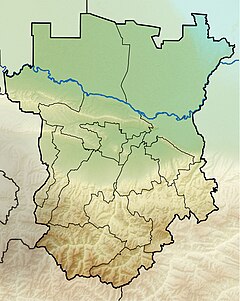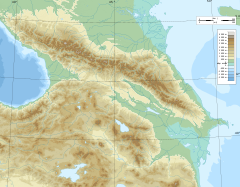This article needs additional citations for verification. (July 2024) |
| Argun | |
|---|---|
 Shatili valley, Georgia | |
| Location | |
| Countries | Georgia and Russia |
| Region | Mtskheta-Mtianeti |
| Federal subject | Chechnya |
| Physical characteristics | |
| Source | |
| • elevation | 2,474 m (8,117 ft) |
| Mouth | Sunzha |
• coordinates | 43°21′12″N 45°56′56″E / 43.3532°N 45.9490°E |
• elevation | 69 m (226 ft) |
| Length | 148 km (92 mi) |
| Basin size | 3,390 km2 (1,310 sq mi) |
| Basin features | |
| Progression | Sunzha→ Terek→ Caspian Sea |
The Argun (Russian: Аргу́н, Chechen: Орга, Orga,[1] Georgian: არღუნი, arghuni), also known as Chantiy-Argun, cognate with one of the biggest Chechen teips Chantiy, is a river in the Caucasus. It flows through the northern Caucasus, Georgia, and the Chechen Republic of Russia. It is an affluent of the Sunzha and lies within the river basin of the Terek. It is 148 kilometres (92 mi) long, and has a drainage basin of 3,390 square kilometres (1,310 sq mi).[2] The river has its sources on the northern slopes of the Caucasus in Khevsureti, Georgia. The Argun flows in western Chechnya through the Itum-Kalinsky and Shatoysky districts.
This area was the first place where the Chechens established themselves. Many ruins of former villages built in the traditional style can still be seen. The Argun serves as a natural border between the Shalinsky and the Groznensky Districts. The occupation of its valley by the Russians in 1858 was an important event in the last phase of the Russian conquest of Chechnya and Dagestan. Before the First and Second Chechen Wars the region around the river was populated by numerous farms and houses. The town of Argun is named after the river.
On September 7, 2008, the only bridge crossing the Argun River, connecting northern and southern territories of Chechnya, collapsed. Drivers caught on the bridge escaped without injury. A federal road administration representative linked the accident to abnormal stress from heavy military vehicles.[3]

- ^ Lepiev A.S., Lepiev İ.A., Türkçe-Çeçençe sözlük, Turkoyŋ-noxçiyŋ doşam, Ankara, 2003
- ^ "Река Аргун (Чанты-Аргун, Аргун) in the State Water Register of Russia". textual.ru (in Russian).
- ^ (in Russian) gazeta.ru, September 7, 2008 [1]



